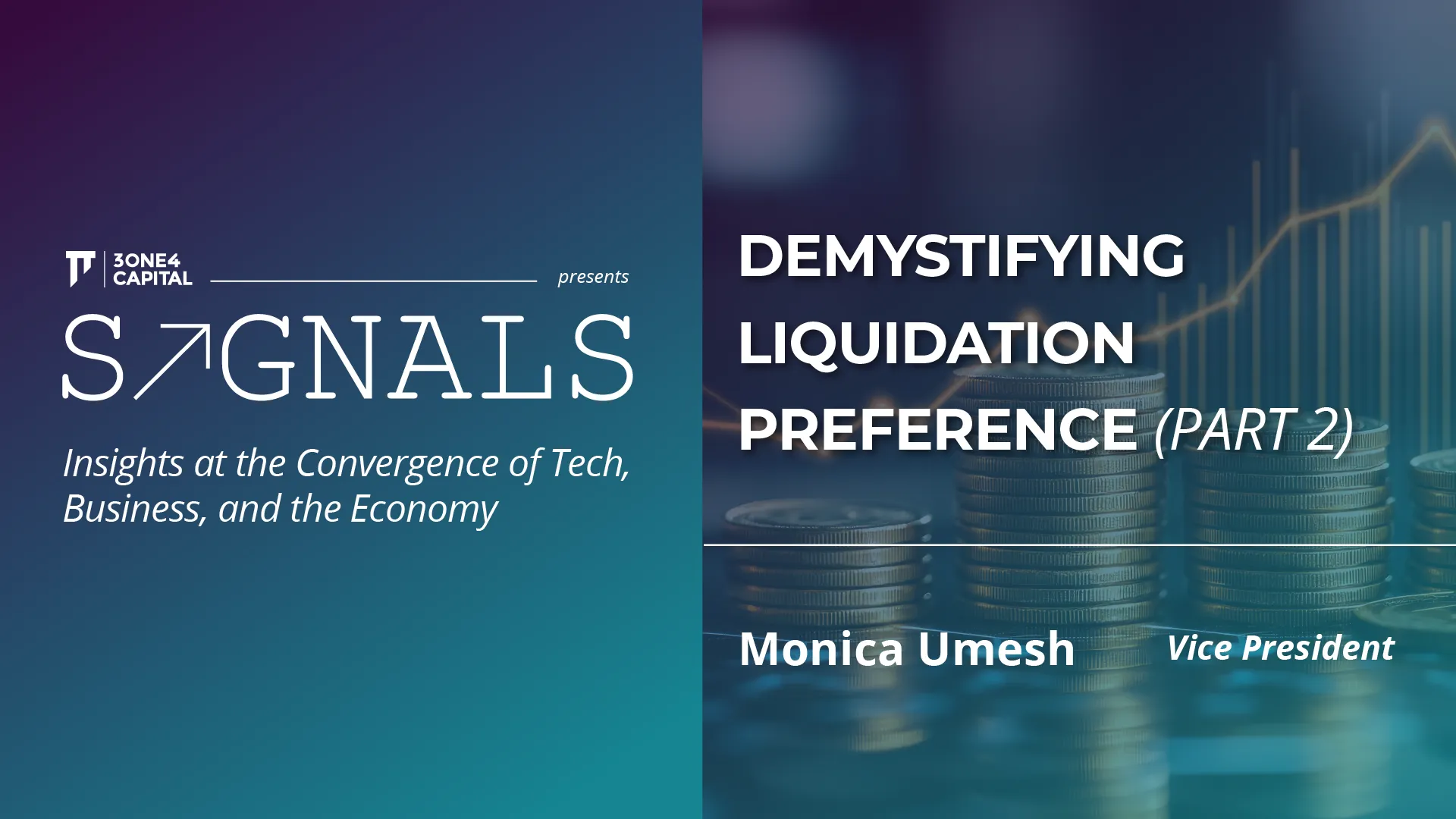
Demystifying Liquidation Preference (Part 2)
Key Components of a Liquidation Preference Clause
A liquidation preference clause will typically read as below:
Upon the occurrence of a Liquidity Event, subject to applicable law, the holders of Preference Shares shall receive a share of the proceeds of the Liquidity Event available for distribution to the Shareholders of the Company, in preference to holders of Equity Shares of the Company, equal to the higher of (“Preference Amount”):
- the pro-rata share of the Investors’ shareholding on an as-if converted basis plus all declared but unpaid dividends; or
- 1 (One) time the Investment Amount plus all declared but unpaid dividends.
Any proceeds remaining after the distribution of the Preference Amount to the holders of Preference Shares shall be distributed among the remaining Shareholders ([excluding4 / including5] the holders of Preference Shares) in proportion to their inter-se shareholding in the Company, along with all declared but unpaid dividends.
Subject to the provisions of applicable law, if upon a Liquidity Event, the Liquidity Event proceeds are insufficient to meet the payment of the Preference Amount described hereunder, then the entire proceeds shall be distributed to the holders of Preference Shares on an inter-se pro rata basis of their Investment Amount.
The critical constructs to understand and keep in mind are below:
- Liquidity Event: The type of transaction undertaken by a company which will result in creation of liquidity at the hands of its shareholders, either directly through sale of shares or indirectly by sale of assets of the company.
- Preference Amount: The predetermined amount that investors receive before other shareholders is either (a) the original investment amount (or a multiple of it) plus declared dividends, or (b) the amount they would get if their preference shares were converted to equity and they shared the proceeds with equity shareholders. Investors get whichever amount amongst the two is higher.
- Conversion Ratio: The preference shares may have a conversion ratio that dictates how they convert into equity shares upon a liquidity event. Depending on the terms of the investment, the preference shares may convert to equity shares at a predetermined ratio, allowing preference shareholders to participate in the distribution of remaining proceeds alongside equity shareholders.
- Calculation basis: The manner or basis for calculation is dependent on the amounts available for distribution and the clause providing for the ‘liquidation preference’:
a) Amount available for distribution is higher than the investment amounts of the investors: The calculations will be based on the investor's proportional shareholding in the company, assuming all shares are converted to equity shares. Based on negotiations and investor comfort, when calculating liquidation preference, the benefit from unallocated ESOPs will go to the shareholders who diluted their shares to create the ESOP pool.
b) Amount available for distribution is equal to the investment amounts of the investors: The calculation will be based on the multiple of investment amount that will have to be returned to the investor (one time investment amount in this case).
c) Amount available for distribution is lower than the investment amounts of the investors: The calculation will be based on the investor’s proportional investment in the company relative to other investors.
- Distribution Order: This provides for the order of priority in which the amounts will be distributed:
a) Seniority – In this structure, the amounts are paid out starting with the most recent round of funding in the company and moving to the earliest. This allows for incentivising a new investor into investing in the company in later rounds. This also depends on the leverage that a new investor has in the later round.
b) Pari passu – In this structure, preference shareholders at all stages have equal seniority. This ensures that every investor receives a portion of the liquidation amount.
c) Tiered – In this case, the investors from various rounds can be organized into different tiers of seniority. This setup combines elements of both standard seniority, where later rounds typically have priority, and pari passu design, where all investors within the same tier are treated equally.
- Downside Protection: If the proceeds are insufficient to provide at least one time (or the relevant multiple of) the investment amount of the preference shareholders, then all the proceeds will be distributed amongst the investors, pro rata to their investments in the company. This is a critical right of investors to ensure that all available amounts are distributed to investors considering the rationale for the investment by them.
Illustration
Moneymaker Private Limited has raised two rounds of funding, Series Seed and Series A, wherein the Series Seed investors invested a total of INR 30 Cr and own 30% of the company and Series A investors invested a total of INR 50 Cr and owns 50% of the company. The founders hold 20% shareholding in the Company.
Moneymaker has sold all its assets and has received INR 90 Cr towards the liquidation proceeds.
The calculations on liquidation preference would be as below:
- Participating Liquidation Preference, pari passu
Clause: The higher of the pro-rata shareholding on an as-if converted basis or 1x the investment amount. After distributing the preference amount, remaining proceeds are shared among all shareholders.
Calculation:
- Preference amount:
- Series A: Higher of INR 50,00,000 or 50% of INR 90,00,000 = INR 50,00,000
- Seed: Higher of INR 30,00,000 or 30% of INR 90,00,000 = INR 30,00,000
- Remaining proceeds: INR 90,00,000 - (INR 50,00,000 + INR 30,00,000) = INR 10,00,000
- Participation in remaining proceeds:
- Series A: 50% of INR 10,00,000 = INR 5,00,000
- Seed: 30% of INR 10,00,000 = INR 3,00,000
- Founders: 20% of INR 10,00,000 = INR 2,00,000
Total payout:
- Series A investors receive INR 50,00,000 + INR 5,00,000 = INR 55,00,000
- Seed investors receive INR 30,00,000 + INR 3,00,000 = INR 33,00,000
- Founders receive INR 2,00,000
- Non-Participating Liquidation Preference, pari passu
Clause: The higher of the pro-rata shareholding on an as-if converted basis or 1x the investment amount. No further participation after preference amount distribution.
Calculation:
- Preference amount:
- Series A: Higher of INR 50,00,000 or 50% of INR 90,00,000 = INR 50,00,000
- Seed: Higher of INR 30,00,000 or 30% of INR 90,00,000 = INR 3,000,000
- Remaining proceeds: INR 90,00,000 - (INR 50,00,000 + INR 30,00,000) = INR 10,00,000
- Founders receive remaining proceeds: INR 10,00,000
Total payout:
- Series A investors receive INR 50,00,000
- Seed investors receive INR 30,00,000
- Founders receive INR 10,00,000
- Waterfall Liquidation Preference, seniority
Clause: Investors are paid back in order of their investment rounds, from latest to earliest. If the proceeds are insufficient, the distribution is on an inter-se pro rata basis of their investment amount.
Calculation:
- Series A (latest round) receives INR 50,00,000 first.
- Remaining proceeds after Series A: INR 90,00,000 - INR 50,00,000 = INR 4,000,000
- Seed receives INR 30,00,000 next.
- Remaining proceeds after Seed: INR 40,00,000 - INR 30,00,000 = INR 10,00,000
- Founders receive remaining proceeds: INR 10,00,000
Total payout:
- Series A investors receive INR 50,00,000
- Seed investors receive INR 30,00,000
- Founders receive INR 10,00,000
For better understanding and hands-on trial of the various liquidation preference scenarios, click here.
Conclusion
Mastering the intricacies of liquidation preferences is more than a theoretical exercise—it's a practical necessity with profound implications for both investors and founders. As we've seen, the structure of liquidation preferences can dramatically influence the distribution of returns during liquidity events, directly affecting financial outcomes for all stakeholders.
For investors, a well-negotiated liquidation preference provides essential downside protection, ensuring that their capital is safeguarded even in less favourable exit scenarios. This can foster greater confidence and willingness to invest, particularly in early-stage ventures where risks are inherently higher. As trends indicate a decline in participating liquidation preferences, investors are signalling a readiness to align more closely with the long-term success of startups rather than prioritizing immediate returns.
For founders, understanding and negotiating favourable liquidation preferences can preserve equity and incentivize growth. By securing terms that balance investor protection with equitable return distribution, founders can maintain greater control over their company and attract investment without overly diluting their own stakes.
Ultimately, the evolution of liquidation preferences reflects a maturing venture capital landscape in India. As stakeholders become more sophisticated in their negotiations, the ecosystem stands to benefit from healthier, more sustainable investment dynamics. Founders and investors alike are better equipped to align their interests, leading to more resilient and successful startups.
By focusing on the outcomes of these financial mechanisms, stakeholders can make strategic decisions that enhance the viability and attractiveness of ventures, driving growth and innovation within the vibrant Indian startup ecosystem.
DISCLAIMER
The views expressed herein are those of the author as of the publication date and are subject to change without notice. Neither the author nor any of the entities under the 3one4 Capital Group have any obligation to update the content. This publications are for informational and educational purposes only and should not be construed as providing any advisory service (including financial, regulatory, or legal). It does not constitute an offer to sell or a solicitation to buy any securities or related financial instruments in any jurisdiction. Readers should perform their own due diligence and consult with relevant advisors before taking any decisions. Any reliance on the information herein is at the reader's own risk, and 3one4 Capital Group assumes no liability for any such reliance.Certain information is based on third-party sources believed to be reliable, but neither the author nor 3one4 Capital Group guarantees its accuracy, recency or completeness. There has been no independent verification of such information or the assumptions on which such information is based, unless expressly mentioned otherwise. References to specific companies, securities, or investment strategies are not endorsements. Unauthorized reproduction, distribution, or use of this document, in whole or in part, is prohibited without prior written consent from the author and/or the 3one4 Capital Group.

.png)












